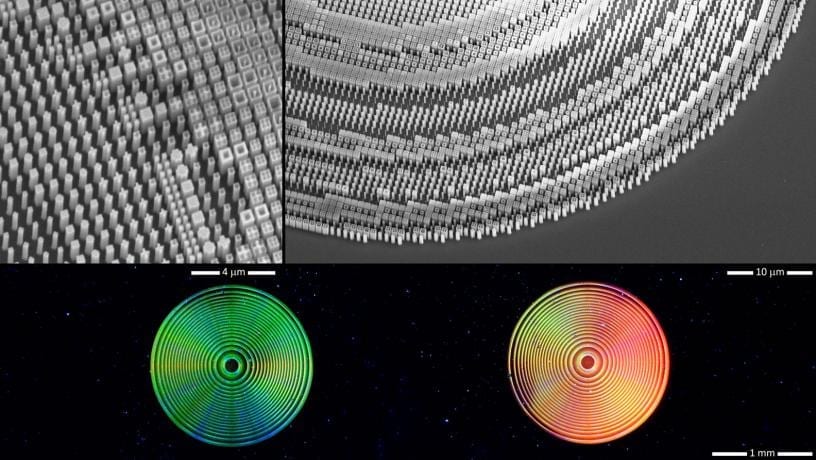
Flat, micron-thick lens offers performance comparable to top-of-the-line compound lens systems; could drastically reduce the size and weight of any optical instruments used for imaging, including cameras, microscopes, telescopes, and eyeglasses.
Light of different colors travels at different speeds in different materials and structures. This is why we see white light split into its constituent colors after refracting through a prism, a phenomenon called dispersion. An ordinary lens cannot focus light of different colors to a single spot due to dispersion. This means different colors are never in focus at the same time, and so an image formed by such a simple lens is inevitably blurred. Conventional imaging systems solve this problem by stacking multiple lenses, but this solution comes at the cost of increased complexity and weight.
Columbia Engineering researchers have created the first flat lens capable of correctly focusing a large range of colors of any polarization to the same focal spot without the need for any additional elements. Only a micron thick, their revolutionary “flat” lens is much thinner than a sheet of paper and offers performance comparable to top-of-the-line compound lens systems. The findings of the team, led by Nanfang Yu, associate professor of applied physics, are outlined in a new study, published today by Light: Science & Applications.
Broadband imaging in the near-infrared using a single meta-lens, showing the ability of the lens in correcting chromatic aberrations, and manufacturing of meta-lenses using planar fabrication techniques similar to those used in the integrated circuits industry.
A conventional lens works by routing all the light falling upon it through different paths so that the whole light wave arrives at the focal point at the same time. It is manufactured to do so by adding an increasing amount of delay to the light as it goes from the edge to the center of the lens. This is why a conventional lens is thicker at its center than at its edge.
With the goal of inventing a thinner, lighter, and cheaper lens, Yu’s team took a different approach. Using their expertise in optical “metasurfaces”—engineered two-dimensional structures—to control light propagation in free space, the researchers built flat lenses made of pixels, or “meta-atoms.” Each meta-atom has a size that is just a fraction of the wavelength of light and delays the light passing through it by a different amount. By patterning a very thin flat layer of nanostructures on a substrate as thin as a human hair, the researchers were able to achieve the same function as a much thicker and heavier conventional lens system. Looking to the future, they anticipate that the meta-lenses could replace bulky lens systems, comparable to the way flat-screen TVs have replaced cathode-ray-tube TVs.
“The beauty of our flat lens is that by using meta-atoms of complex shapes, it not only provides the correct distribution of delay for a single color of light but also for a continuous spectrum of light,” Yu says. “And because they are so thin, they have the potential to drastically reduce the size and weight of any optical instrument or device used for imaging, such as cameras, microscopes, telescopes, and even our eyeglasses. Think of a pair of eyeglasses with a thickness thinner than a sheet of paper, smartphone cameras that do not bulge out, thin patches of imaging and sensing systems for driverless cars and drones, and miniaturized tools for medical imaging applications.”
Yu’s team fabricated the meta-lenses using standard 2D planar fabrication techniques similar to those used for fabricating computer chips. They say the process of mass manufacturing meta-lenses should be a good deal simpler than producing computer chips, as they need to define just one layer of nanostructures—in comparison, modern computer chips need numerous layers, some as many as 100. The advantage of the flat meta-lenses is that, unlike conventional lenses, they do not need to go through the costly and time-consuming grinding and polishing processes.“The production of our flat lenses can be massively parallelized, yielding large quantities of high performance and cheap lenses,” notes Sajan Shrestha, a doctoral student in Yu’s group who was co-lead author of the study. “We can therefore send our lens designs to semiconductor foundries for mass production and benefit from economies of scale inherent in the industry.”Because the flat lens can focus light with wavelengths ranging from 1.2 to 1.7 microns in the near-infrared to the same focal spot, it can form “colorful” images in the near-infrared band because all of the colors are in focus at the same time—essential for color photography. The lens can focus light of any arbitrary polarization state, so that it works not only in a lab setting, where the polarization can be well controlled, but also in real world applications, where ambient light has random polarization. It also works for transmitted light, convenient for integration into an optical system.
“Our design algorithm exhausts all degrees of freedom in sculpting an interface into a binary pattern, and, as a result, our flat lenses are able to reach performance approaching the theoretic limit that a single nanostructured interface can possibly achieve,” Adam Overvig, the study’s other co-lead author and also a doctoral student with Yu, says. “In fact, we’ve demonstrated a few flat lenses with the best theoretically possible combined traits: for a given meta-lens diameter, we have achieved the tightest focal spot over the largest wavelength range.”
Adds University of Pennsylvania H. Nedwill Ramsey Professor Nader Engheta, an expert in nanophotonics and metamaterials who was not involved with this study: “This is an elegant work from Professor Nanfang Yu’s group and it is an exciting development in the field of flat optics. This achromatic meta-lens, which is the state-of-the-art in engineering of metasurfaces, can open doors to new innovations in a diverse set of applications involving imaging, sensing, and compact camera technology.”
Now that the meta-lenses built by Yu and his colleagues are approaching the performance of high-quality imaging lens sets, with much smaller weight and size, the team has another challenge: improving the lenses’ efficiency. The flat lenses currently are not optimal because a small fraction of the incident optical power is either reflected by the flat lens, or scattered into unwanted directions. The team is optimistic that the issue of efficiency is not fundamental, and they are busy inventing new design strategies to address the efficiency problem. They are also in talks with industry on further developing and licensing the technology.
Meta-lenses composed of nano-structured thin films could enable full-color imaging. They have the potential to replace bulky imaging systems, comparable to the way flat-screen TVs have replaced cathode-ray-tube TVs.
Learn more: Revolutionary Ultra-thin “Meta-lens” Enables Full-color Imaging
The Latest on: Meta-lens
[google_news title=”” keyword=”meta-lens” num_posts=”10″ blurb_length=”0″ show_thumb=”left”]
via Google News
The Latest on: Meta-lens
- Ray-Ban Meta encourages ‘living all in,’ seeing the world in style with smart glasseson April 26, 2024 at 2:33 pm
An effortlessly cool protagonist showcases how a pair of stylish smart glasses makes mundane moments extraordinary.
- What the New Ray-Ban Meta Smart Glasses Mean for Travelerson April 26, 2024 at 10:51 am
Now that’s possible with updates to the Ray-Ban Meta smart glasses, according to Meta, the company that owns Facebook, Instagram, and Whatsapp. The big tech company said this week that it is updating ...
- Meta is still working on its AR glasses, and they’re supposedly pretty neaton April 26, 2024 at 7:26 am
Project Nazare, Meta’s fully augmented reality glasses, was first revealed in 2021. Now Meta’s Head of AR Glasses Hardware, Caitlin Kalinowski, has revealed a few more details about these AR glasses ...
- See the World Smarter: Ray-Ban Meta Glasses Get Multimodal AIon April 24, 2024 at 3:58 pm
Ray-Ban Meta glasses' new AI assistant can identify what you see, answer questions, and make calls. All without you reaching for your phone.
- More Smarts Coming To Meta’s Ray-Ban Smart Glasses Collaborationon April 24, 2024 at 3:21 pm
Smart glasses and headsets are in a moment of flux and innovation. Luxottica and Meta executives say they're bringing a new version of their smart Ray-Bans in "weeks." ...
- Meta's Ray-Ban smart glasses just got another useful feature for free (and a new style)on April 24, 2024 at 9:22 am
The improvements to the Ray-Ban Meta glasses and sunglasses include better integration with Apple Music, support for multimodal AI, and compatibility with WhatsApp and Messenger, allowing users to ...
- Ray-Ban Meta smart glasses get a much-needed style revampon April 23, 2024 at 8:15 pm
New Meta smart glasses feature fresh designs and AI capabilities for better user experience. Meta CEO Mark Zuckerberg announced new colorways and features to enhance the product's appeal. Users in ...
- The Ray-Ban Meta Smart Glasses get video calling, Apple Music, and a new styleon April 23, 2024 at 12:53 pm
You can peep a pretty clear demo of the video calling feature from Zuckerberg’s reel. In it, he talks to Eva Chen, who runs fashion at Instagram, about the new Skyler frames and... chain lengths, of ...
- Meta Smart Glasses just got the AI upgrade I’ve been waiting foron April 23, 2024 at 12:33 pm
Meta keeps making its Ray-Ban Smart Glasses better, with more styles, multimodal AI that can see, and the option to share your view with friends.
via Bing News










